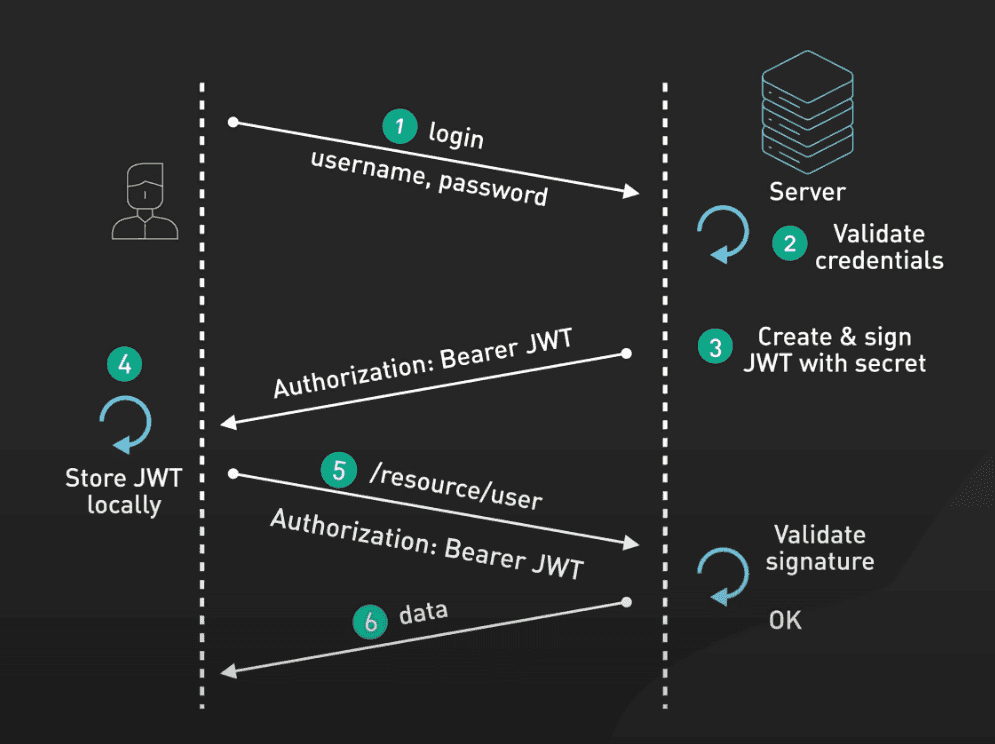Do you know how Modern Stateless Authentication works?
Last updated by Tom Bui [SSW] 2 months ago.See historyStateless authentication with JWT overcomes traditional session-based limitations by eliminating server-side session storage, thereby boosting scalability and security. This approach simplifies user verification across distributed systems without the scalability and security concerns associated with the session based approach, making it more aligned with modern web development needs.
Video: Why is JWT popular (5 min)Modern stateless authentication, leveraging JSON web tokens (JWT), offers a scalable solution for managing user authentication without server-side storage. The OIDC framework, building on OAuth 2.0, standardizes interactions between authentication services and users. JWTs, containing a header, payload, and signature, ensure data integrity and authentication validity. Issued by trusted identity providers, these tokens facilitate user identification in applications, moving away from traditional session-based methods. This approach enhances scalability and user management, aligning with current web development trends.
The Process of Stateless Authentication with JWT
User Authentication
- The user authenticates to the identity provider
- Upon successful authentication, the provider generates a JWT, which includes claims about the user and is signed with a secure key
- The JWT is then returned to the client application, usually via an HTTP response
Token Storage
- The client application receives the JWT, and must store and handle it securely to reduce the risk of compromise
Authorized Access
- For subsequent requests to your resource available at your application backend server, the client includes the JWT in the request headers as a Bearer token
- The server, upon receiving a request with a JWT, verifies the token's signature and the validity of its claims against the authority
- If the token is valid, the server grants access to the requested resource which in most cases is an API

Token Expiry and Refresh Mechanism
- JWTs typically have an expiration time set by the issuer; once expired, the user must re-authenticate to obtain a new token
- Often, a refresh token mechanism is employed, where a longer-lived refresh token is issued alongside the JWT
- The refresh token can be used to sliently obtain new access tokens without requiring the user to re-authenticate, enhancing the user experience while maintaining security
Benefits of JWT in Stateless Authentication
- Scalability: As the resource doesn't store session data, it can easily handle requests from a large number of users without a significant impact on performance
- Flexibility: JWTs can be used across different domains and in various architectures making them suitable for modern, distributed applications
- Performance: Carrying relevant user information within tokens can reduce database queries, improving the overall performance of the application
Security Considerations for JWT Authentication
Proper security measures are essential in handling JWTs to prevent unauthorized access and breaches:
- Sensitive Information: Avoid storing sensitive data in JWT payloads as they are not encrypted and can be exposed to unauthorized parties
- Secure Storage: Prefer HttpOnly cookies over local storage for JWTs to mitigate the risk of Cross-Site Scripting (XSS) attacks; HttpOnly cookies enhance security by restricting access to tokens via JavaScript
- Token Expiry: Implement short-lived JWTs to reduce the risk window in case of token compromise - Short expiration times necessitate more frequent token renewal, enhancing security
- Transmission Security: Use HTTPS to ensure encrypted communication between client and server, protecting token data during transit
- Validation and Revocation: Validate JWTs on each request to verify their integrity and authenticity also consider token revocation mechanisms for additional security, such as maintaining a list of invalidated tokens
Adopting these practices helps maintain the integrity of JWT-based authentication and protects against potential security threats.
Understanding and implementing modern stateless authentication with JWTs is crucial for developing secure and scalable web applications. By following the best practices for token management and security, developers can build robust authentication systems that cater to the needs of modern web applications.
For more insights and technical implementations, consider exploring additional resources such as Auth0's guide on Stateless Sessions for Stateful Minds and LogRocket's blog on JWT authentication best practices.


